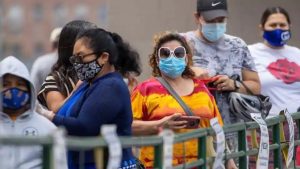California has more than 538,000 confirmed virus cases, and on Friday became the third US state to exceed 10,000 deaths from Covid-19.

Customers wait in line to shop for food at a Food 4 Less grocery store, during the outbreak of the coronavirus disease (Covid-19), in Los Angeles, California, US on August 5, 2020.
California officials have identified two data glitches that caused the state to undercount new coronavirus cases for more than a week, leaving a backlog of as many as 300,000 lab records to process.
The held-up test results will probably be worked through in one to two days, Mark Ghaly, California’s Health and Human Services secretary, said in a briefing Friday. The data reporting issues, first disclosed on Tuesday, have left public health officials unable to trust numbers showing cases slowing in the state with the most US infections.
Two overlapping issues created the problem, Ghaly said. On July 25, a server outage in the state’s centralized reporting system prompted workers to install a temporary patch that, over days, interfered with the proper flow of lab records. Then, on the 31st, the system stopped receiving records from one of the largest commercial labs in the state’s testing program, Quest Diagnostics, after a certificate that needs to be renewed every two years expired.
Both problems have since been fixed, Ghaly said. But state officials are now building a new system to track disease data, since the old one, known as CalREDIE, wasn’t designed to handle this many records.
There are 250,000 to 300,000 lab records that are left to process, and the exact effect on California’s coronavirus case counts isn’t yet known, Ghaly said. The state’s 14-day average rate of positive tests — which may be affected by the backlog — is at 6.1%. Some of the jammed-up records will be duplicates, while others will be for other infectious diseases tracked by the same systems.
California has more than 538,000 confirmed virus cases, and on Friday became the third US state to exceed 10,000 deaths from Covid-19. Earlier this week, before the data glitches came to light, Governor Gavin Newsom said slowing new case counts offered “encouraging” signs the state may have turned a corner in its outbreak.
Ghaly said that after checking with hospitals around the state, he believes accurate data won’t change the underlying trend of improvement. New case counts, he said, appear to be stabilizing and trending down after July’s spike. The state’s data show hospitalizations, unaffected by the reporting issues, have fallen 17% from a peak.
“We do feel confident in the trends,” Ghaly said.

